YOU ARE HERE >> AmazingRibs » Ratings & Reviews » Weber SmokeFire EX4 And EX6 Wood Fired Pellet Grill Review
Weber SmokeFire EX4 And EX6 Wood Fired Pellet Grill Review
All of our reviews are done independently by our team of testers and are in no way influenced by advertising or other monetary compensation from manufacturers. Click here to learn more about our unbiased product review process.
Published On: 3/23/2020 Last Modified: 6/13/2025
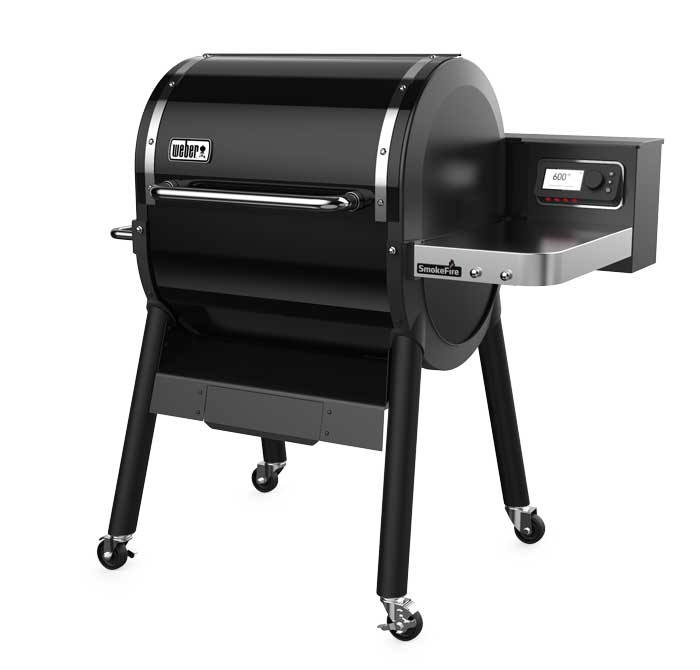
Buy EX4 on BBQGuys.com Free Shipping
Buy EX6 on BBQGuys.com Free Shipping
Looks like once the existing inventory is gone, Smokefire will no longer be offered in the USA. Weber states, “We are transitioning our pellet offering to Searwood in the US and will not manufacture new SmokeFire grills for the North American market. The SmokeFire pellet grill will continue to delight cooks worldwide. We are committed to supporting every SmokeFire grill owner’s enjoyment of this unique cooker — assisting them with their needs, answering questions, and providing ongoing cooking inspiration.”
We purchased our Weber SmokeFire EX4 (the 24” model) in February 2020 shortly after Weber began shipping them, and we ran it through our thorough testing regimen. Unfortunately, we were scooped because within days of shipping, several consumers, YouTubers, and bloggers had already dismissed it as a “dumpster fire” after only a few cooks.
Well, after more than a few cooks and tests, we can say that there are indeed some serious flaws, many of them have easy remedies, SmokeFire is by no means a “dumpster fire,” and in fact there is a lot to like about the clever innovations in this grill/smoker.
We have never felt so ambivalent about a new design. We give it a Silver Medal, equivalent to 3 out of 5 stars, right in the middle of our rating scale. If Weber makes a few changes, it could rate much higher.
In addition to our tests, we viewed as many of the videos and read as many comments from owners as we could. We also interviewed some of the naysayers as well as engineers at Weber. At this point, we think we understand this machine pretty well. Our conclusion:
PROS
- SmokeFire smokes as well as any other pellet smoker we have tested, We give it a Silver Medal, equivalent to 3 out of 5 stars, right in the middle of our rating scale.
- The center of SmokeFire achieves higher temperatures and produces more infrared energy than any pellet smoker we have tested and does a better job of searing a steak than any pellet smoker we have tested.
- Dreaded pellet jams seem impossible if you use Weber-branded pellets, and should one happen, it would be easy to remedy.
- “Burn back”, when the pellets in the auger catch on fire, is impossible.
- A sensor alerts you when the pellet hopper is running low.
- It is easy to change pellets of different wood types.
- The intuitive app and control panel are designed to make cooking easy for the novice. A recent over the air update now enables users to monitor and control SmokeFire from anywhere, such as in front of the TV, at the office, or while out running errands. Additionally, SmokeFire now has “SmokeBoost” which is intended to amp up smoke flavor.
- There is no grease bucket in the open air and within reach of dogs, bugs, and vermin as on many competitors’ models.
- It is well built and the porcelain enamel finish will not rust easily.
- It comes in two sizes: 24 inch or 36 inch cooking surfaces.
- Competitively priced.
- Excellent warranty.
- Grilling on it is just plain fun.
- The food is excellent.
CONS
- The app was not fully functional when the device shipped. A few months later, Weber provided a significant over the air update that added remote temperature and shutdown controls, “SmokeBoost” for extra smoke, and other attractive features.
- The controller needed a firmware update right out of the box. Some early users did not run the update, and they were in for problems right from the get go.
- The LCD screen on the controller has problems in frigid weather.
- Under some conditions there can be flareups, but they don’t last long with the lid down.
- Under some conditions there can be grease fires, but they are easily prevented.
- A lot of sparks fly around. These glowing embers go out quickly but they could be a fire hazard.
- A lot of ash flies around outside the cooking chamber but somehow doesn’t land on your food.
- Pellets did not feed properly. Weber has shipped a hopper insert fix. It did not solve the problem for us. They are shipping all current models with the insert pre-installed.
- The cooking surface does not heat evenly from left to right. The range of temperature variation is significant.
- It is easy to make mistakes assembling the device and that can cause performance issues.
- It can jam when fed non-Weber brand pellets.
- It needs a work shelf on the front. Weber now offers optional fold down side shelves and front shelves.
Like what you’re reading? Click here to get Smoke Signals, our free monthly email that tells you about new articles, recipes, product reviews, science, myth-busting, and more. Be Amazing!
At long last, a pellet cooker that can really sear
Let’s talk about the design of this machine and the innovations that make it special, and in some cases, also make it problematic. First, some pellet cooker basics. These cookers work by combusting wood pellets. The pellets are made of compressed sawdust extruded into tubes about the thickness of a pencil and then broken into chunks about 1/2” long. No glues are used, just pressure. The pellets are stored in a hopper on the cooker. Set the temperature on the digital controller, and it turns an auger that feeds pellets from the hopper into a firepot about the size of a beer mug. In the firepot, the pellets are ignited by a small glowing heating element. Software controls the speed of the auger and a fan that blows air into the firepot, and combined they control the temperature. Within a few minutes, the cooking chamber is smoking away and soon reaches your set temperature. The pellets burn very efficiently creating a pleasant, if understated, smoke flavor. Some cooks find the smoke flavor too mild. Most people love it. Some machines, like this one, come with a smartphone app that allows you to control the device remotely, and a few, like this one, even have settings for different meats. Click here to read more about how pellet smokers work.
We have always referred to pellet cookers as pellet smokers, never pellet grills, because ever since they were introduced in the 1980s, they have functioned as indirect heat ovens similar to the way an indoor oven works. In most pellet smokers, the heat source (firepot) sits beneath a metal plate as pictured below. Notice that the metal plate is slightly tilted to divert grease into a tray and/or bucket. This design does a great job at grease management. If you love smoked turkey, ribs, brisket, salmon, and more, it doesn’t get any easier than cooking on a pellet smoker.
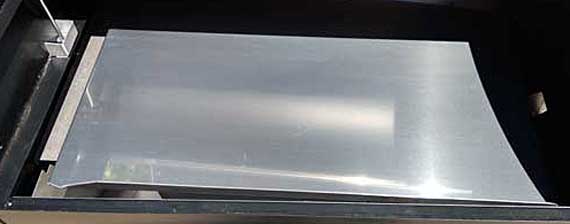
Until SmokeFire, if you wanted a perfect sear on a steak or burger, you had to put the meat in a hot pan, on a griddle, or a griddle-like surface such as GrillGrates. Why is this important? Because brown tastes good. When foods sear and brown, chemical reactions called the Maillard reactions and caramelization happen, and they create desirable flavors. The browner the merrier, which is why we prefer to see an all-over browning of the surface rather than the partial browning of grill marks. Click here to learn more about these chemical reactions, why brown is beautiful, and why we don’t want grill marks.
Unfortunately, hot air does not deliver enough energy to properly brown the surface of a steak. Browning is best done by hot metal, like a griddle or by infrared radiation (IR), from glowing coals or a flame. Think about how your toaster browns bread but your oven doesn’t. Lots of IR in that toaster, not much in an oven. Most pellet smokers are like ovens. Click here to learn more about the thermodynamics of grilling.
Some pellet smokers are designed to expose a section of the cooking surface to direct flame called a sear zone. But that sear zone just never seems to properly sear a steak, and certainly no more than one or two, due to its small size.
SmokeFire is designed like Weber’s gas grills with inverted V shaped “flavorizer bars” so that the meat is exposed to a lot more direct flame and IR across the entire cooking surface.
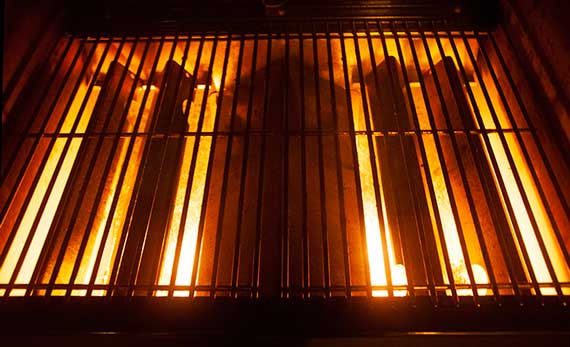
As a result, you can actually get a good sear, especially in the center where the heat source is located. With fan and flames blowing, it feels like a gas and charcoal grill rolled into one. Here is the first steak we cooked on it:
We were impressed with the sear power of SmokeFire, but when we put six steaks across the surface from left to right, we noticed the steaks in the center seared best, on the right smoked nicely, on the left, less perfectly. Three distinct zones. This disappointed us. If you have more than four steaks to sear you probably should cook them in batches, or plan on leaving those on the cooler, left side on for a few minutes longer.
The heating pattern was confirmed with our standard bread test. After toasting bread for seven minutes at 350°F, we flipped the slices over and saw this.
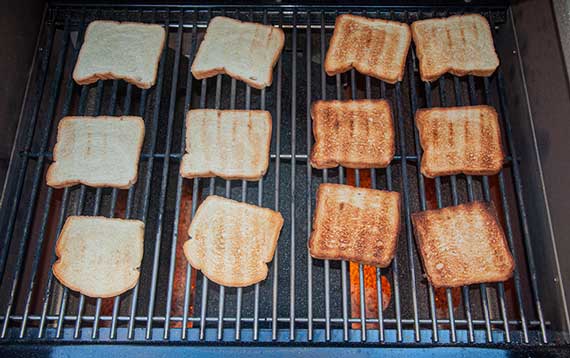
The controller uses a probe in the center at the rear. We set the controller to three different temperatures and checked the actual temps from left to right using the six probes of a Fireboard thermometer.
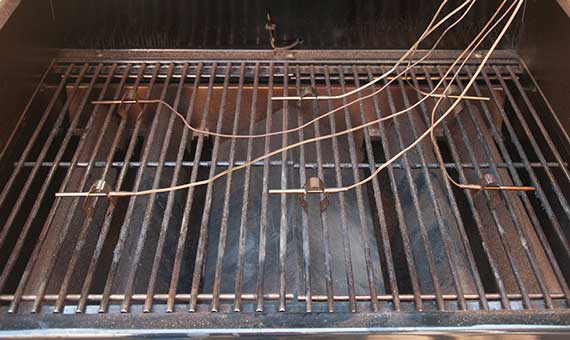
Our tests confirmed SmokeFire’s left to right variation and confirmed its impressive upper temperature range, which surpasses 600°F, even higher than most gas grills.
| Controller | Left | Middle | Right |
|---|---|---|---|
| 225°F | 225°F | 240°F | 286°F |
| 325°F | 335°F | 340°F | 397°F |
| 600°F | 658°F | 718°F | 686°F |
Weber is adamant that a closed lid promotes more even heat and encourages owners to keep the lid down as much as possible. Our thermometer and bread tests were done lid down. Notice the highest number in the chart above. We’ll take the heat, but be mindful when exploring SmokeFire’s upper temperature range. Weber claims that it will shut down if the average temperature reaches 700°F for a short, sustained period. They did not say what is a sustained period, but at that temperature it is likely to incinerate your food and melt vinyl siding if you are too close.
Up your game: Join our Pitmaster Club. Try it out for free for 30 days. No credit card is needed. No spam. Join now and Be Amazing!
Grease and ash management
By using flavorizer bars like those used on Weber gas grills, SmokeFire allows grease to drip to the bottom of the cookbox, where it is channeled to a combo grease and ash pan that slides out from the lower front.
The flavorizer bars are stainless steel while the large heat shield in the center is enameled steel. Weber claims the enameled center shield allows grease to roll off better than the stainless.
Beneath the enamel coated shield there is a flame deflector directly over the firepot.
The flame deflector helps distribute heat and smoke left and right and along with the firepot design, these direct flying ash away from the cookbox, preventing ash from landing on the food. Weber states one of the daunting challenges they faced when they replaced the solid diffuser plate with flavorizer bars was dealing with ash flying around inside the cooking chamber. They developed several fly ash reduction schemes. Chief among them was cutting slots in the bottom of the firepot so ash would fall straight down and out of the cooking chamber and into an ash collection pan below. A great idea.
On most other pellet cookers, failure to remove ash from the firepot can prevent pellet ignition or shut the machine down in the middle of a cook. Then you’re forced to remove food and everything between you and your ash laden firepot to get back in business. And it is all hot.
A few pellet smokers have slide out firepot bottoms that empty into a removable cup. Throughout our tests, Weber’s firepot design has effectively kept our firepot clear of ash. The ash collection tray doubles as the grease collection tray and the tray is tucked away below the cooking chamber inside the body of the unit where it can be easily removed for disposal. Note that if you slide the pan out to check while cooking, as we did, ash can accumulate at the back, preventing the drawer from closing back up all the way. Shop Vacs provide a simple solution. Suck up the ash at the back and your drawer will again close properly. Despite that quibble, this grease collection design is better than most: on many pellet smokers, a grease bucket hangs on the outside of the unit, where the grease can attract bees, flies, mice, and dogs.
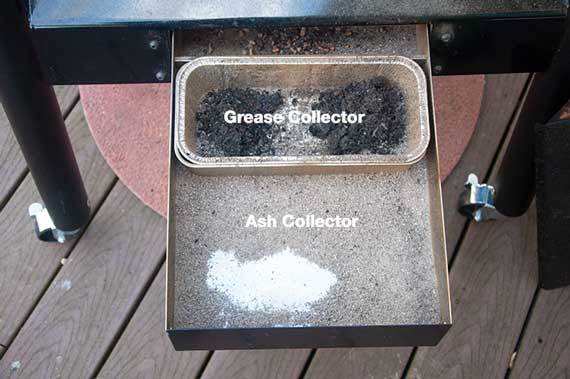
Not every last bit of ash is collected. The fan that provides oxygen to the burning pellets blows some of ash through air vents outside the unit, where it lands on the shiny black exterior. This appearance of ash caused concern from early reviewers fearful that ash would get on their food inside the cookbox. But the firepot, heat shield and ash collection mechanisms prevent that. To check, we wrapped a paver stone with a white towel and smoked it at 225°F for 2 hours. There was no ash. And the towel was delicious.
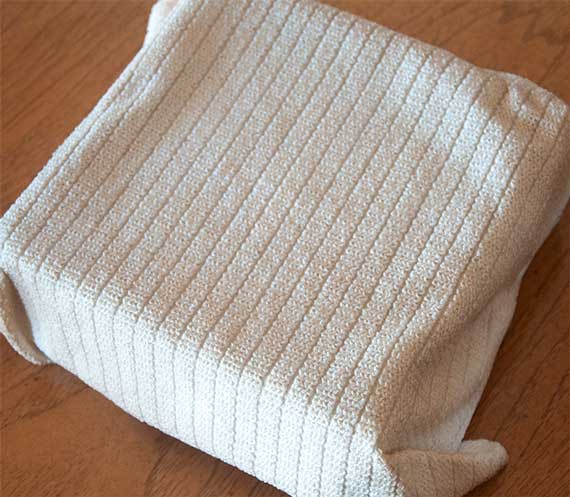
However, we did observe sporadic, tiny glowing embers falling from the ash drawer, remnants of expired pellets that refused to die. Although they were few and far between, we fear they could be a fire hazard for flammable surfaces below. We strongly recommend using a grill mat if it is on a deck or anything flammable. Click here for a nice grill mat available on Amazon.
Potential grease fires
In our tests, some of the ash flew out of the firepot and settled around the outside of the firepot. Alas, that’s where the holes to drain grease are located, so after a cooking session or two you should lift out the heat deflector and flame deflector, easy to do, and brush the ash down the grease drain holes. This picture shows the grease channels and drain holes on each side of the fire pot.
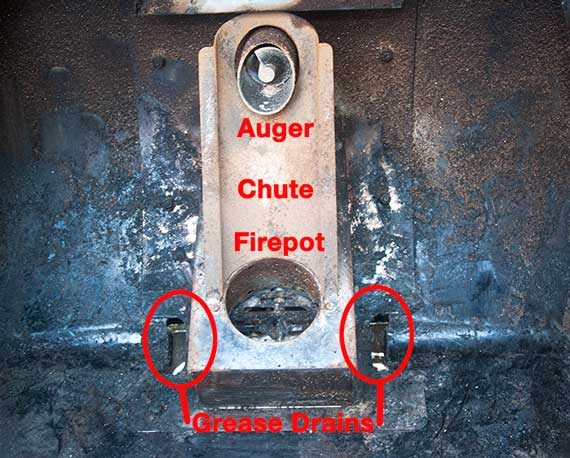
If you do not periodically remove this ash, it can mix with grease and block the drain holes as shown in the picture. Notice the drain hole on the right is clogged.
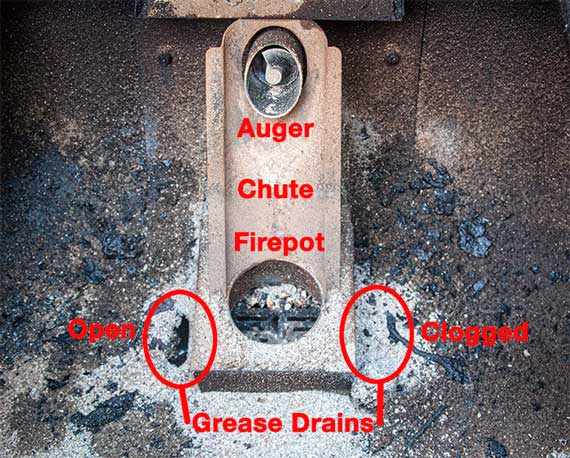
Let’s say you’re cooking a fatty cut for a long time and the drain hole clogs. As the fat renders, most of it burns off on the flavorizer bars, but some can pool in the bottom of the unit. A wayward spark could ignite the grease. And that is exactly what has happened to a number of users.
To test for this, over a period of a few days, we made full loads of chicken wings, sausages, 25% fat burgers, pork belly, and a whole packer brisket. We were literally asking for trouble but, thankfully, didn’t get any flare ups or grease fires. That said, if you take a whole 18 pound packer brisket, leave its 1” fat cap on, put it fat down over the center of the smoker, and decide to cook it at 325°F, you are likely to create a pool of fat down below.
Simply sweeping away the ash or sucking it up with a shop vac will prevent grease fires. How often should you do this? Hard to say. Weber recommends cleaning after every 20 hours of operation, which is typical and good preventive maintenance for any pellet smoker. Vacuums are indispensable for pellet smoker clean ups. We use a cordless handheld for light ash removal, but cleaning up after our grease fire test was a job for our shop vac. After vacuuming the dry ash, out came the scraper Weber supplies to handle the sludge, which had solidified into chunks in the cold, winter weather during our tests. We used a trowel for some of the larger chunks, and were able to scrape the rest down into the grease/ash pan. Please note: Grease fires can and do happen in gas grills too if you do not clean them periodically. Click here for our tips on grill cleaning and maintenance.
Another workaround is to put disposable aluminum pans under the cooking grates to catch grease. While it is true that you don’t have to do this with other pellet smokers, many cooks, including Yours Truly, often apply an aluminum foil liner or drip pans for easy clean up. And if you are doing a long cook of a brisket or pork butt, remove most of the fat cap. It is a myth that melting fat makes the meat moister.
Clearly Weber should have designed the grease drain system so it cannot be clogged by ash, and they should make a point of telling users to clean out the ash often.
We don’t like blaming the victim, but we were disappointed that one of the first YouTubers to report a grease fire got so mad that he never figured out what the problem was. He just called the device a disaster and returned it. And that bad review ended up igniting an internet dumpster fire. We have since discussed the issue with him and he regrets not being more analytical.
An angled auger that also runs in reverse
On most pellet smokers, the auger that feeds pellets into the firepot is set horizontally from the hopper to the firepot. SmokeFire uses a short, eight inch auger set on an angle. Note the pitch of the auger. This photo is level. The auger is angled instead of level and points upward to the left of the photo. The inclined auger moves pellets a short distance from the hopper, then drops them down a pellet chute into the firepot.
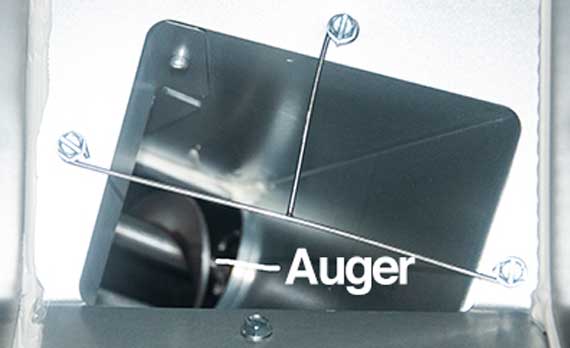
It also runs in reverse when you shut the machine off so there are no pellets left in the auger. This design feature should totally eliminate pellet jams. On some competitors’ machines, pellets can stay in the auger, crumble, and jam up the auger so that you have to disassemble the guts of the machine. This process can take an hour or more on some machines, a serious setback when you are on the clock. Weber’s auger motor also runs on DC current rather than AC, which is becoming a trend on newer pellet smokers and is said to enhance system efficiency.
The picture here was taken inside the pellet hopper after we emptied out the pellets. At the top, is a laser light sensor that detects when the pellet level drops to about two pounds, which triggers a low fuel warning on the control panel and, eventually, in the app as well (currently, the low fuel alert does not appear in the app). A metal piece at the bottom of the hopper slides out to open a pellet drain chute for emptying the hopper so you can change pellet types. Weber makes pellets from maple, hickory, cherry, and a blend of all three so you can choose your favorite smoking wood.
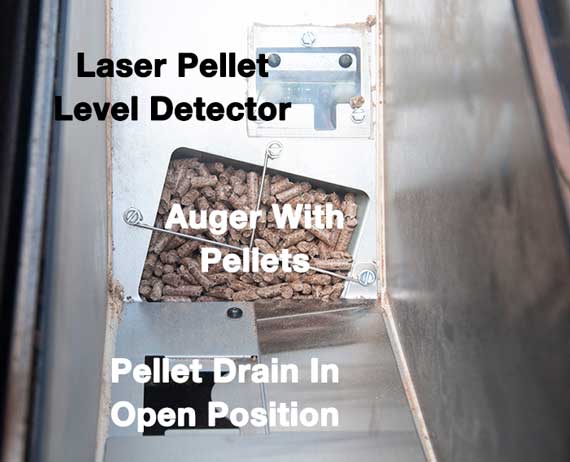
Here’s a look inside the cooking chamber so you can see the end of the auger, the pellet chute, and the firepot.
The pellet chute and angled auger are safety features. On most pellet smokers, the auger feed is in close proximity to the firepot. Smoke and heat can travel up from the firepot through the auger tube and into the pellet hopper, where it can ignite pellets in the hopper. Although rare, this troublesome issue known as “burn back” can occur. SmokeFire’s angled auger helps prevent burn back.
And SmokeFire goes a step further to eliminate burn back. When you are finished cooking and select “shut down mode”, the cooker does the following before powering off: First it expels pellets at the end of the auger feed, then the auger goes in reverse, pulling any fresh pellets already in the auger back into the hopper to ensure all fuel is unexposed and stored safely away as the unit shuts down.
Want a new set of tools? Check out Meathead’s new book, The Meathead Method. It’s a toolbox that will elevate all your cooking. Alton Brown calls it “The only book on outdoor cookery you’ll ever need.”
Unique pellet hopper
Another complaint we’ve heard is about the pellet hopper itself. The 22 pound hopper is located at the back rather than off to one side as on most pellet smokers. That’s not an issue, but instead of a tall box shape, the hopper is long and shallow with the auger feed opening on the left side as shown. Pellets on the left easily enter the auger feed door just below the depression in the pellets in the photo below, while those on the right linger in a pile. This “funneling” happens to a degree on all pellet hoppers, but funneling on SmokeFire is more pronounced than any we’ve seen.
After just a few hours, SmokeFire’s pellet feeding was so inconsistent that we feared the auger would empty, even though there were still pellets in the hopper. Of course, one of the joys of pellet smoking is the set-it-and-forget-it convenience. We routinely throw pork butts and beef briskets on at night and go to bed confident that the digital control system will take care of business while we snooze. But if you have to get up in the middle of the night to push the pellets to the auger feed door, well, that’s a pain.
So we did some tests. First, we ran SmokeFire at at 225°F without food and completely unattended. After 9 1/2 hours, the controller displayed the low pellet fuel warning. Now, we knew a brisket would take longer than 9 1/2 hours to cook but decided to give it a go anyway. After all, smoking a brisket for upwards of 12 hours is a real world scenario. We set SmokeFire to 225°F, loaded the brisket, and let it go overnight. We ignored the low pellet fuel warning and it ran for 12 hours before the temperature began to fall because pellets were not feeding. At that point, the system shut down from lack of fuel, and the sight under the pellet hopper hood, below, was unsettling.
We are bewildered that this defect escaped Weber’s R&D before going to market. To remedy this pellet feeding problem, Weber is shipping a complimentary ramp insert that raises the incline. Unfortunately, the new insert reduces the capacity of the 22 pound hopper to about 20 pounds. We tested the insert on our EX4. Installation was easy, requiring just two screws. But the results were disappointing. Not only did the insert fail to fix the issue; it became worse! With the cooker set at 225°F, pellets went from lasting 12 hours down to only 10 hours. To double check, we repeated our test the following night and got the same results. On a positive note, we spoke with an owner of the larger EX6 who said the insert completely cured his pellet feed issue. Weber now pre-installs inserts on all models.
You must use Weber pellets
On the first day of testing, we encountered some startup issues. We weren’t sure if it was the smoker, the pellets, or something else. We dutifully followed the startup procedure in the manual but kept getting a “Start Up Failure” error which automatically shut the system down. The manual instructs you to open the grill, select cooking temp using the dial on the controller, then close the lid once smoke becomes visible. All of which we did. Yet the controller LCD display immediately advised us that the grill was warming up and we should close the lid, even though smoke was not yet visible. We called Weber and they said to follow the manual. They even asked if we left the lid open for a prolonged time after start up, which can wreak havoc on the controller. Leaving the lid open on any thermostatically controlled cooking device will, of course, make the control system go into overdrive trying to reach and hold a set temp while cooler air is blowing freely into the unit. This discrepancy could have caused some of the complaints among early users of SmokeFire. Hopefully this contradictory message will be addressed with the software updates. One wonders, however, with all its sophistication, if this machine could not sense the lid is open? Despite all this, however, we did not leave the lid up for long. When smoke became visible, we closed it as instructed in the manual.
To help solve our startup issue, Weber speculated that we might be using a competitive brand of pellets and/or they might have been old and stored poorly. All of that was true. We were using Traeger pellets we got on sale a few months before and stored them in an unheated garage over the winter. We learned that Weber pellets have a smaller diameter than most brands, something you can see just by looking at them. Weber said that although any decent, fresh pellets should work in SmokeFire regardless of their diameter, some thicker pellets may get jammed in the auger chute. Hmmmmmm….OK. We picked up a bunch of the thinner Weber pellets, cleared out the old pellets through the hopper clean-out chute, and vacuumed out any remaining pellets. Although we had been using the older Traeger pellets on another smoker for weeks without incident, after switching to the Weber pellets on the SmokeFire, we had no further “Start Up Failure” issues.
Software
WE REPEAT: Before you can fire up your machine you must download a firmware update. The simple instructions are on page 10 of the manual.
Digitally controlled pellet smokers are well suited for remote control and monitoring from a smartphone, and this feature is gaining popularity. Out of the box, our SmokeFire app was bare bones with few features. New software often is buggy and requires minor updates after the initial launch, but SmokeFire’s software needed major updating to live up to the hype. Weber is a company that built a sterling reputation for building equipment. With SmokeFire, they have become a software company and that’s not an easy transition. Months after Weber’s launch, we received a few over the air updates that expanded app capabilities and were finally able to control SmokeFire remotely.
The difference was night and day. Previously, the app only allowed us to monitor cooking temp and internal meat temp with Weber’s integrated meat probe. The upgrades enabled us to adjust the cooking temp higher or lower, shut the unit down, and we received alarms when set cooking temp and meat target temp were reached. These useful and convenient features have been enjoyed by owners of Traeger’s WiFIRE models, and other WiFi enabled pellet smokers like Green Mountain Grills for years, so Weber was playing catch up. Better late than never, and it appears SmokeFire is now off and running. Weber is also adding more video to their guided recipes and they continue to implement behind the scenes upgrades to improve performance. Another new feature is “SmokeBoost” which is meant to produce extra smoke flavor. We’re in the process of exploring these new Weber Connect upgrades.
Apart from the app itself, connecting WiFi pellet smokers to your internet network can sometimes be a problem that’s hard to troubleshoot. The issue could be your modem, your router, or your internet service. While we have had significant connectivity issues with other cookers, we are happy to report that we were able to connect to SmokeFire quickly and effortlessly.
We did have a minor problem with the control panel itself. On cold, 20°F evenings near the end of our Chicago winter, spinning the control dial failed to advance the set temp. This is a common occurrence with LCD screens that you may have noticed in cold weather if you have an LCD on your car dashboard. Molecules in liquid crystals slow down when the temperatures drop, and the only remedy is warming them up. In extremely cold weather, let SmokeFire reach the default temp of 200°F before using the dial to set the cooking temp.
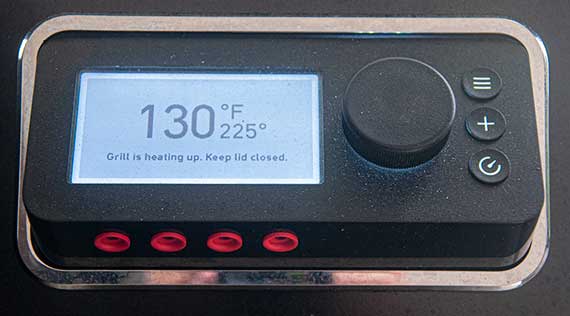
As you can see on the controller pictured here, SmokeFire has four red temperature probe ports to monitor meat and/or air temperatures. It ships with only one probe, but additional probes can be purchased. The probe wires thread through a notched opening near the upper right side of the lid.
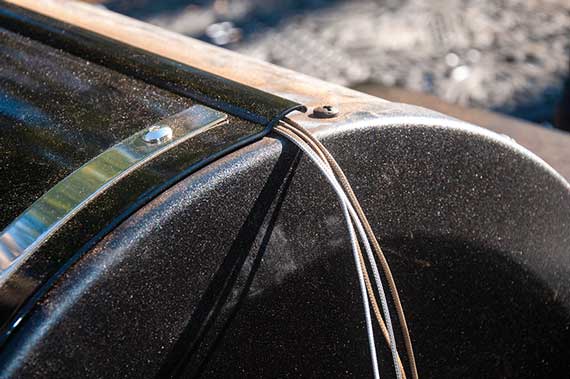
This probe system is different from other grills and smokers that provide a probe portal on the side of the cookbox itself. Both designs are effective and useful.
We installed a few probes and started cooking. Although Weber stated plainly that the app needed significant updates at the time of our initial tests, the app did have a limited number of “Weber Connect” guided recipes that offer cooking instruction. We chose a guided recipe for 1 1/2 inch thick steaks and placed one steak on the left side of the cooker and one on the right. The recipe was pretty simple and just advised to set the temp to 525°F then alerted us to flip the steaks after four minutes and remove them after another four minutes. Both steaks were the same size and thickness and spent the same time on the grill. The results were OK. Both steaks got intense sear marks from the grates instead of the all over brown finish we prefer. Apparently the software doesn’t know that frequent flipping creates more flavor on the surface. Also, the steak on the left was done rare while the one on the right was more medium rare. The steak on the left could have grilled for another minute or two. We look forward to exploring the upgraded recipes and the new “SmokeBoost”
We’ll revisit the guided recipes when the app is upd.ated. Meanwhile, refer to our article on How To Cook A Steak Like A Pro. You’ll be glad you did!
Construction
SmokeFire’s body is enamel coated steel with double walled sides for insulation. There is no chimney. Instead, SmokeFire has exhaust vents that run across the back from left to right and vent onto the hopper lid. After our greasy flare up test, the vents deposited some sticky gunk on the hopper lid.
This design also blows hot, moisture laden air right onto the hopper.
Cooking grates are plated steel. The EX4 main cooking grate surface is 18 inches x 24 inches. The EX6 is 18 inches x 36 inches.
A handy side shelf is adjacent to the controller on the right and Weber also offers optional fold down left side shelves and front shelves. They did not say when. The four sturdy legs roll on casters which we found more than adequate for residential use. A handle on the left side helps when moving the grill.
Some of our readers asked if SmokeFire can accommodate Weber’s Gourmet Barbecue System that integrates various cooking surfaces such as pizza stones and woks. Weber told us the geometry for the SmokeFire grills is the same as Spirit Gas Grills. The EX4 (24 inch) grates are the same size as a Spirit 3-burner so these can be upgraded to a cast iron or Gourmet Barbecue System cook grate that fits these grills. The EX6 (36 inch) is the same, with the exception that you must add another 12 inch grate to fit the 36 inch span.
We’ve also been asked if the 36 inch model has a larger firepot than the 24 inch. It does not. This is typical of most pellet smoker models offered in different sizes. Weber states that the larger size model will consume slightly more fuel but feels the difference is negligible.
Warranty
SmokeFire Grills are manufactured in Huntley, Illinois, using globally sourced parts. The electrical components, cooking grates, pellet chute, firepot, heat baffle, pellet grate, and controller bezel have a three year warranty. The cookbox and all other components have a five year warranty.
Packaging and assembly
Weber’s SmokeFire packaging process is integrated with the overall product design in a holistic manner. Unpacking and assembly steps are logical, making the task relatively easy for me.
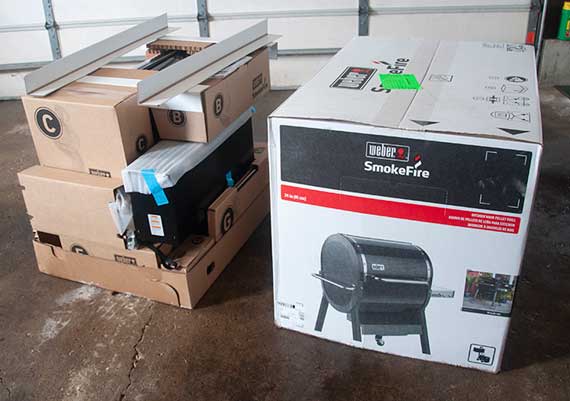
Although we didn’t find SmokeFire assembly confusing, some have. We fear that some of the initial bad reviews were caused by improper assembly. We viewed the YouTube videos and saw such anomalies as glowing pellets outside the firepot. Indeed, in at least one case, the user confessed that incorrect assembly was in fact his problem. We have also heard from others that they had the store assemble their cooker and the store made mistakes.
Nonetheless, we blame Weber for making the parts so they can be fitted together improperly causing such problems. Great engineering makes sure there is only one way to assemble a product. Pay special attention to assembly instructions to avoid malfunction. Weber recommends using their free assembly app called BILT, available for iOS and Android.
Want a new set of tools? Check out Meathead’s new book, The Meathead Method. It’s a toolbox that will elevate all your cooking. Alton Brown calls it “The only book on outdoor cookery you’ll ever need.”
Food quality
The best news: We cooked a lot of food on this baby and everything we cooked was excellent. Here are some notes on a few cooks. We like to sear skirt steaks for fajitas hot and fast, but decided not to crank SmokeFire all the way to its top setting of 600°F. We played it safe at 550°F, and it was a pretty sight. Onions and poblano peppers sizzled fast at about two minutes per side.
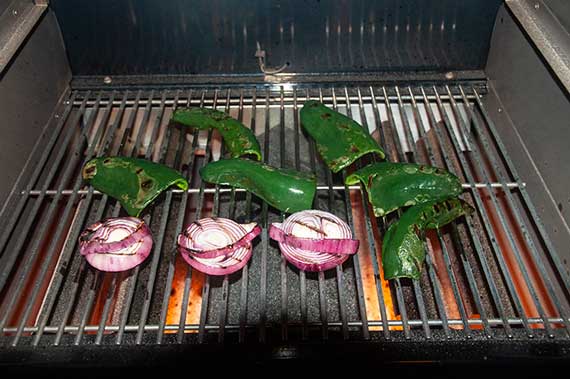
The skirt steak got a proper grilling as well. The results were very good, but we regret not blasting SmokeFire all the way to 600°F to smack those thin skirt steaks with even more searing heat. Be careful here. SmokeFire gets rippin’ hot! You can crank it all the way for thin steaks, shrimp and anything you want to sear really hot, really fast. For everything else, proceed with caution until you get to know this sear machine.
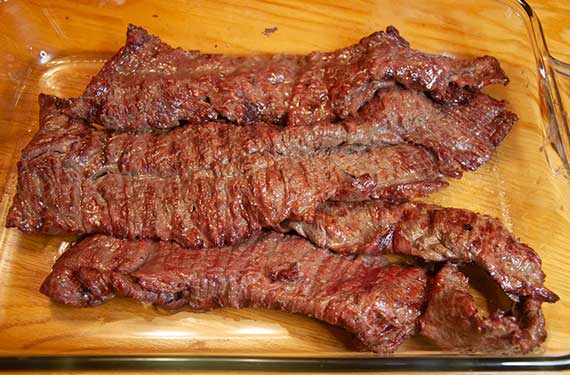
Here’s a couple pork butts we smoked for 8 hours at 225°F. Many new owners remark that the smoke flavor is very good. We agree. Not too mild, not too strong.
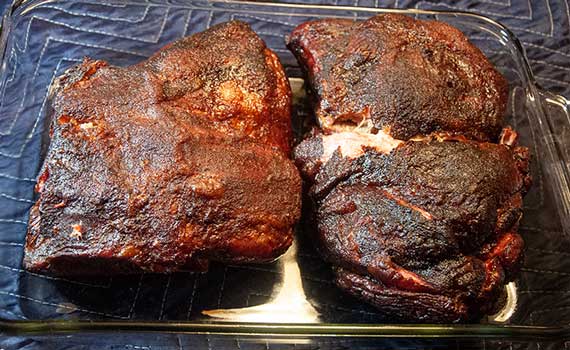
Note the beautiful, mahogany finish and absence of fly ash deposits. Ditto for our whole packer brisket smoked for 12 hours.
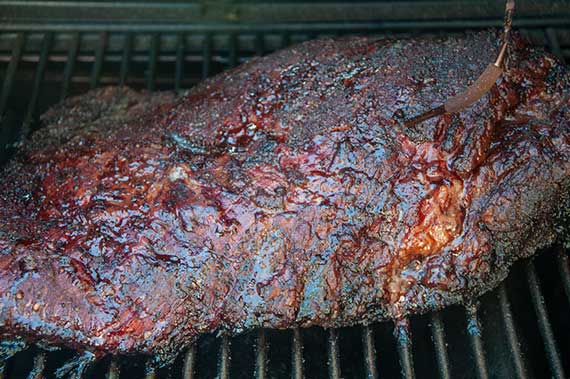
Conclusion
While it’s not the least expensive pellet cooker available, the actual selling price undercuts Traeger’s comparable Ironwood models. We listed the 24 inch EX4 MSRP (Manufacturer’s Suggested Retail Price) below at $1,150, but Webers always sell for MAP (Minimum Advertised Price), which is $999. The 36 inch EX6 model is available with a MAP of $1,200.
We like a lot about SmokeFire and conclude that it is indeed a game changer. We’ve tested many pellet smokers that claim searing capability, but none knocked our socks off like SmokeFire. Weber has taken a lot of flak for SmokeFire’s shortcomings. Some deserved, some not. We applaud Weber for choosing bold innovation over a safe, “me too” design for their entry into the pellet smoker market.
Weber updated their software and app over the air and it is now fully functioning. If they can come up with a fix for the grease fires and pellet feeds our rating could become Gold Medal (4 stars out of 5). If they can get it to heat more evenly and scratch off most of the rest of the items in our list of Cons above, it could go Platinum Medal.
Should you buy it now? Wait for version 2? Or choose from the many other models in the exploding pellet smoker category? As always, the answer depends on you. If you want an all-in-one pellet smoker/grill right now that’s capable of smoking low and slow, searing steaks, and anything in between, SmokeFire is it. Even if you already have a grill and just want to get a good quality pellet smoker, it’s still worth looking at, warts and all. Just be certain to clean out the ash, check the pellet flow in the hopper, and be aware of the left to right temperature differentials. If that is daunting, there are plenty of other choices in all shapes, sizes, and price ranges.
Warranty
Electrical components, cooking grates, pellet slide, burn pot, heat baffle, pellet grate, controller bezel – 3 years
Cook box and all other components – 5 years
Subscribe to Smoke Signals, our free email newsletter, for notification when we revise this review and when we publish reviews of other grills and smokers.
Click the buttons below to search our complete database of reviews:
Product Information:
-
Model:SmokeFire EX4 24" Wood Fired Pellet Grill
-
Item Price :1,150.00
*Price Subject To Change -
Where to buy (buying from this supplier supports this website):
-
Review Method:Cooked On It
We have hands-on experience testing this product. We have also gathered info from the manufacturer, owners and other reliable sources. -
Primary Function:Grill, Smoker, Combination Grill and Smoker
-
Fuel:Wood Pellets
-
Primary Capacity:Mid-Size (about 21 burgers) : 432 square inches
-
Secondary Capacity:240 square inches
Manufacturer:
-
Weber-Stephen
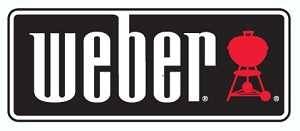
Weber-Stephen is one of the oldest and most respected manufacturers of BBQ equipment and related accessories in the world. Weber grills and smokers cook beautifully and have great features that are clever, effective and easy to use. As popularity and demand for BBQ gear grows worldwide, Weber continues to earn their long standing reputation for quality, durability and outstanding customer service and support, (7 days a week from 7am to 8pm CST), in an increasingly competitive environment. Even in this crowded marketplace, many consumers are still willing to pay more for the Weber name and they are rarely disappointed. They make a variety of cookers and smokers. Their iconic black charcoal kettles are known throughout the world. Indeed Weber is expanding globally.
Weber-Stephen was family owned since it was founded in 1952 by George Stephen. At the end of 2010 the Stephen family sold a majority stake to Chicago investment group BDT Capital Partners. In 2012, Weber settled a class action suit out of court regarding their use of the phrase, “Made in USA”. Weber previously qualified the “Made in USA” statement by specifying their products are assembled in the USA with some components that are sourced globally. Here is an excerpt from Weber’s statement “Weber believes that because all Weber grills and the disputed accessories are designed and engineered in the USA, and all grills save for one line [Spirit]* are manufactured and assembled in the USA using component parts primarily made in the USA, it did nothing wrong and therefore has valid defenses to plaintiff’s claims. The court has not held a trial or ruled in favor of either party on any disputed issues. Weber and the plaintiff have agreed to settle the matter to avoid the costs of continued litigation.” As a result of this suit, Weber can no longer claim to be made in America.
Since then Weber, like many others, has outsourced manufacturing of more product lines. Things change, but we believe Weber’s commitment to quality and innovation has not.
The biggest barrier for many folks is price. Webers are not cheap, but when you consider that they last decades, the price is easy to justify. Many some cheap grills fall apart after three years or so.
Our main complaint: All Webers have the obligatory bi-metal dial thermometer in the hood that gives you a ballpark reading of what the temperature is high above the meat. Since we cook on the grates, though, it’s always better to bring your own digital thermometer and place a probe there. It appears this is beginning to change as Weber enters a new era of digital technology and software based products.
Related reviews
- June Oven Premium Review And Rating
- Sneak Peek: Weber SmokeFire Sear+ Review And Rating
- Weber Searwood 600 Pellet Grill Review And Rating
-
Max Good, AmazingRibs.com’s Full-Time Grill Tester - Max Good is AmazingRibs.com's Vice President of Product Reviews & Keeper of the Flame and is the world's only full-time reviewer of outdoor cooking equipment including smokers, grills, pizza ovens, griddles, and more.


High quality websites are expensive to run. If you help us, we’ll pay you back bigtime with an ad-free experience and a lot of freebies!
Millions come to AmazingRibs.com every month for high quality tested recipes, tips on technique, science, mythbusting, product reviews, and inspiration. But it is expensive to run a website with more than 2,000 pages and we don’t have a big corporate partner to subsidize us.
Our most important source of sustenance is people who join our Pitmaster Club. But please don’t think of it as a donation. Members get MANY great benefits. We block all third-party ads, we give members free ebooks, magazines, interviews, webinars, more recipes, a monthly sweepstakes with prizes worth up to $2,000, discounts on products, and best of all a community of like-minded cooks free of flame wars. Click below to see all the benefits, take a free 30 day trial, and help keep this site alive.
Post comments and questions below
1) Please try the search box at the top of every page before you ask for help.
2) Try to post your question to the appropriate page.
3) Tell us everything we need to know to help such as the type of cooker and thermometer. Dial thermometers are often off by as much as 50°F so if you are not using a good digital thermometer we probably can’t help you with time and temp questions. Please read this article about thermometers.
4) If you are a member of the Pitmaster Club, your comments login is probably different.
5) Posts with links in them may not appear immediately.
Moderators